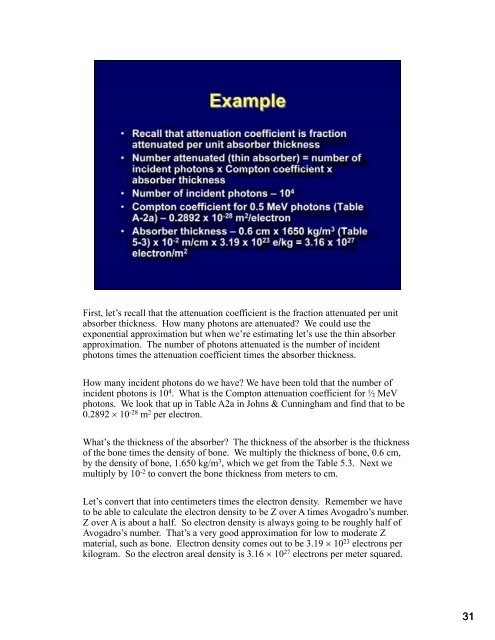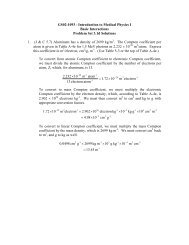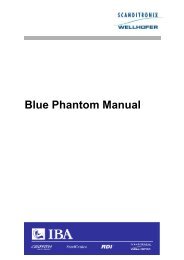link to lecture transcript - UT-H GSBS Medical Physics Class Site
link to lecture transcript - UT-H GSBS Medical Physics Class Site
link to lecture transcript - UT-H GSBS Medical Physics Class Site
You also want an ePaper? Increase the reach of your titles
YUMPU automatically turns print PDFs into web optimized ePapers that Google loves.
First, let’s recall that the attenuation coefficient is the fraction attenuated per unit<br />
absorber b b thickness. hi k How many pho<strong>to</strong>ns h are attenuated? d? We could ld use the h<br />
exponential approximation but when we’re estimating let’s use the thin absorber<br />
approximation. The number of pho<strong>to</strong>ns attenuated is the number of incident<br />
pho<strong>to</strong>ns times the attenuation coefficient times the absorber thickness.<br />
How many incident pho<strong>to</strong>ns do we have? We have been <strong>to</strong>ld that the number of<br />
incident pho<strong>to</strong>ns is 104 cdetp o<strong>to</strong>ss 0. . WWhat at is s the t e Comp<strong>to</strong>n Co p<strong>to</strong> attenuation atte uat o coefficient coe c e t for o ½ MeV eV<br />
pho<strong>to</strong>ns. We look that up in Table A2a in Johns & Cunningham and find that <strong>to</strong> be<br />
0.2892 10-28 m2 per electron.<br />
What’s the thickness of the absorber? The thickness of the absorber is the thickness<br />
of the bone times the density of bone. We multiply the thickness of bone, 0.6 cm,<br />
by the density of bone, 1.650 kg/m3 , which we get from the Table 5.3. Next we<br />
multiply by 10-2 multiply by 10 <strong>to</strong> convert the bone thickness from meters <strong>to</strong> cm<br />
2 <strong>to</strong> convert the bone thickness from meters <strong>to</strong> cm.<br />
Let’s convert that in<strong>to</strong> centimeters times the electron density. Remember we have<br />
<strong>to</strong> be able <strong>to</strong> calculate the electron density <strong>to</strong> be Z over A times Avogadro’s number.<br />
Z over A is about a half. So electron density is always going <strong>to</strong> be roughly half of<br />
Avogadro’s number. That’s a very good approximation for low <strong>to</strong> moderate Z<br />
material, such as bone. Electron density comes out <strong>to</strong> be 3.19 10 23 electrons per<br />
kilogram. So the electron areal density is 3.16 10 27 electrons per meter squared.<br />
31





